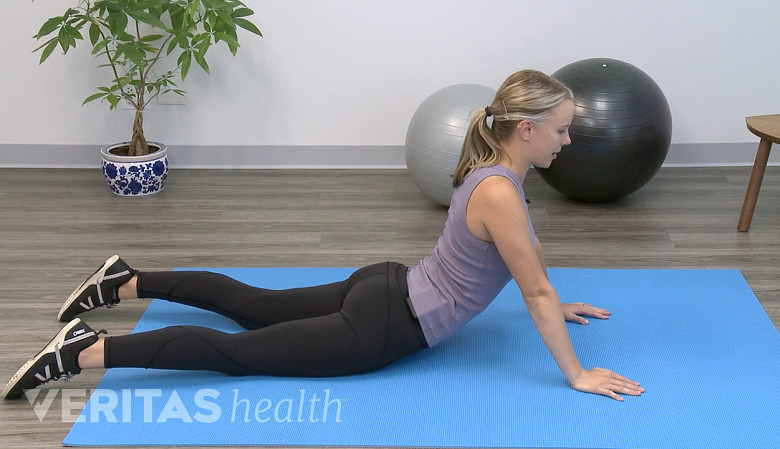Walking, swimming, and cycling are excellent weight loss exercises for people with back pain. These activities minimize stress on the spine.
Managing weight while dealing with back pain requires careful exercise selection. High-impact activities can exacerbate pain, so low-impact options are preferable. Walking is a simple yet effective way to burn calories without straining the back. Swimming offers full-body conditioning and supports the body, reducing stress on the spine.
Cycling, particularly on a stationary bike, allows for cardiovascular benefits with minimal back strain. Incorporating these exercises can help maintain a healthy weight, improve overall fitness, and alleviate back pain. Always consult a healthcare professional before starting any new exercise regimen to ensure it is safe and suitable for your specific condition.
Gentle Cardio Options
Weight loss exercises can be challenging for people with back pain. Gentle cardio options offer a safe way to stay active. These exercises keep you moving without adding stress to your back. Explore some gentle cardio options to help you lose weight and manage back pain.
Walking Benefits
Walking is a simple and effective exercise. It is easy on your back and helps in weight loss. Here are some key benefits of walking:
- Low Impact: Walking is gentle on your joints and back.
- Burns Calories: A brisk 30-minute walk can burn around 150 calories.
- Improves Mood: Walking releases endorphins, improving your mood.
- Strengthens Muscles: Walking helps strengthen your leg and core muscles.
Walking also helps improve your posture. Good posture reduces back pain. You can walk anywhere, making it a convenient exercise. Here is a simple walking plan for beginners:
| Day | Duration |
|---|---|
| Day 1 | 10 minutes |
| Day 2 | 15 minutes |
| Day 3 | 20 minutes |
| Day 4 | 25 minutes |
| Day 5 | 30 minutes |
Start slow and gradually increase your walking time. Always wear comfortable shoes. Walking on a flat surface is best for your back.
Swimming Advantages
Swimming is another excellent gentle cardio option. It provides a full-body workout without straining your back. Here are some benefits of swimming:
- Low Impact: Swimming reduces the stress on your spine.
- Burns Calories: An hour of swimming can burn up to 500 calories.
- Improves Flexibility: Swimming helps improve your body’s flexibility.
- Strengthens Muscles: Swimming strengthens your muscles, including those supporting your back.
Swimming also helps improve your cardiovascular health. It makes your heart and lungs stronger. Here are some swimming strokes suitable for people with back pain:
| Stroke | Benefits |
|---|---|
| Freestyle | Improves overall body strength and endurance. |
| Backstroke | Gentle on the back and improves posture. |
| Breaststroke | Good for flexibility and muscle tone. |
Always warm up before swimming. Start with slow strokes and gradually increase your pace. Swimming in warm water can also help soothe back pain.

Credit: m.youtube.com
Strength Training Basics
Weight loss exercises for people with back pain require special consideration. Strength training plays a crucial role in maintaining overall fitness and supporting weight loss. It helps build muscle, improve posture, and reduce the strain on the back. Understanding the basics of strength training can make a significant difference for those dealing with back pain.
Core Stability Exercises
Core stability exercises are essential for people with back pain. A strong core supports the spine and reduces pressure on the back. Here are some simple exercises:
- Planks: Start in a push-up position. Keep your body straight. Hold for 30 seconds.
- Bird-Dog: Begin on your hands and knees. Extend one arm and the opposite leg. Hold for a few seconds. Switch sides.
- Bridges: Lie on your back with knees bent. Lift your hips off the ground. Hold for a few seconds and lower.
These exercises can be done anywhere. They do not require special equipment. Consistency is key to seeing results. Aim for 3 sets of each exercise, 2-3 times a week.
| Exercise | Reps | Sets |
|---|---|---|
| Planks | Hold for 30 seconds | 3 |
| Bird-Dog | 10 per side | 3 |
| Bridges | 10 | 3 |
Low-impact Resistance
Low-impact resistance exercises are perfect for people with back pain. They help build strength without straining the back. Some effective low-impact exercises include:
- Resistance Bands: Use bands for bicep curls, shoulder presses, and squats. These bands are gentle on joints.
- Water Aerobics: The water supports your body. This reduces stress on the back while providing resistance.
- Chair Squats: Use a chair for support. Squat down as if sitting, then stand up. This strengthens the legs and core.
Low-impact resistance exercises are versatile. They can be modified to suit your fitness level. Here’s a sample routine:
| Exercise | Reps | Sets |
|---|---|---|
| Resistance Bands | 10-15 | 3 |
| Water Aerobics | 30 minutes | 1 |
| Chair Squats | 10-15 | 3 |
These exercises help in maintaining muscle strength. They also aid in weight loss. Always listen to your body and rest if you feel pain.
Flexibility And Stretching
Weight loss exercises for people with back pain need special consideration. Flexibility and stretching play a crucial role. They can help relieve pain, improve mobility, and support weight loss. This section explores gentle yoga poses and dynamic stretching techniques that are safe for the back.
Gentle Yoga Poses
Yoga is excellent for improving flexibility and reducing back pain. Here are some gentle yoga poses:
- Child’s Pose (Balasana): This pose stretches the spine and relieves tension. Kneel on the floor, sit back on your heels, and stretch your arms forward.
- Cat-Cow Stretch: This sequence stretches the back and improves flexibility. Start on all fours, arch your back (Cow Pose), and then round it (Cat Pose).
- Downward-Facing Dog (Adho Mukha Svanasana): This pose stretches the back and hamstrings. Begin on all fours, lift your hips, and straighten your legs.
- Supine Twist: This pose stretches the spine and reduces tension. Lie on your back, bend your knees, and gently let them fall to one side.
Yoga helps strengthen the core muscles. Strong core muscles support the back. Practicing yoga regularly can prevent future back pain. Always move slowly and listen to your body. Avoid poses that cause pain.
Dynamic Stretching Techniques
Dynamic stretching prepares the muscles for exercise. It involves moving parts of your body and gradually increasing reach and speed. Here are some effective dynamic stretches:
- Hip Circles: Stand with your feet hip-width apart. Move your hips in a circular motion. This stretch loosens the lower back and hip muscles.
- Arm Swings: Swing your arms forward and backward. This stretch warms up the shoulders and upper back muscles.
- Leg Swings: Stand on one leg and swing the other leg forward and backward. This stretch improves hip flexibility and balance.
- Torso Twists: Stand with your feet shoulder-width apart. Twist your torso from side to side. This stretch increases spinal flexibility.
Dynamic stretching can reduce stiffness and increase the range of motion. It should be done before any physical activity. This helps prevent injury and prepares the body for more intense exercise. Always start with gentle movements and increase the intensity gradually.
Mind-body Practices
People with back pain often find it hard to lose weight. Mind-body practices can help them exercise without making their pain worse. These practices focus on gentle movements and breathing, which can ease pain and promote weight loss.
Pilates Fundamentals
Pilates is a low-impact exercise that strengthens muscles and improves flexibility. It focuses on core strength, which is crucial for back pain sufferers. Here are some key points about Pilates:
- Core Strength: Strengthening the core muscles supports the back.
- Flexibility: Gentle stretching improves range of motion.
- Posture: Good posture reduces back pain.
Basic Pilates Exercises for beginners include:
- Pelvic Tilts: Lie on your back with knees bent. Tilt your pelvis to flatten your lower back.
- Bridges: Lie on your back, lift your hips, hold for a few seconds, then lower.
- Cat-Cow Stretch: On all fours, arch your back up (cat) and then down (cow).
| Exercise | Reps |
|---|---|
| Pelvic Tilts | 10-15 |
| Bridges | 10-15 |
| Cat-Cow Stretch | 10-15 |
Pilates can be done at home or in a class. Start slow and increase intensity as your strength improves. Always consult a doctor before starting new exercises, especially with back pain.
Tai Chi Benefits
Tai Chi is an ancient Chinese practice that combines slow, deliberate movements with deep breathing. It’s gentle and low-impact, making it perfect for people with back pain. Some benefits of Tai Chi include:
- Pain Relief: Reduces back pain through gentle movements.
- Balance and Coordination: Improves stability and prevents falls.
- Stress Reduction: Calming effect helps manage pain.
Basic Tai Chi Movements to try:
- Commencement: Stand with feet shoulder-width apart, arms by your sides. Slowly raise your arms, then lower them.
- Grasp the Bird’s Tail: Step forward, shift weight, and move arms in a circular motion.
- Single Whip: Step to the side, extend one arm, and pull the other back.
| Movement | Reps |
|---|---|
| Commencement | 5-10 |
| Grasp the Bird’s Tail | 5-10 |
| Single Whip | 5-10 |
Tai Chi can be practiced anywhere, indoors or outdoors. It requires no special equipment. Regular practice can lead to long-term pain relief and weight loss. Always check with a healthcare provider before starting any new exercise routine.
Low-impact Sports
Finding the right weight loss exercises for people with back pain can be challenging. Low-impact sports are ideal for reducing stress on the spine while still burning calories. These activities help you stay active without worsening back pain. Let’s explore two effective low-impact sports: cycling and rowing.
Cycling For Back Pain
Cycling is a fantastic low-impact exercise that keeps your back safe. It strengthens your legs and enhances cardiovascular health. Here are some benefits and tips for cycling:
- Low-Impact: Cycling reduces pressure on your spine compared to running.
- Adjustable Intensity: You can control the resistance to suit your comfort level.
- Improves Posture: Proper biking posture supports your back muscles.
To make the most of cycling:
- Choose a recumbent bike for better back support.
- Adjust the seat height to keep your knees slightly bent.
- Maintain a straight back and engage your core muscles.
- Avoid hunching over the handlebars.
Here’s a quick comparison of different types of bikes:
| Bike Type | Back Support | Best For |
|---|---|---|
| Recumbent Bike | Excellent | Back Pain Relief |
| Upright Bike | Moderate | Cardio Workouts |
| Stationary Bike | Good | Indoor Training |
Rowing Machine Use
The rowing machine is another excellent low-impact option. It provides a full-body workout while being gentle on your back. Rowing strengthens muscles and burns calories effectively.
Key benefits of using a rowing machine:
- Full-Body Workout: Engages arms, legs, and core muscles.
- Low-Impact: Minimizes strain on the back.
- Improves Posture: Encourages proper spinal alignment.
To safely use a rowing machine:
- Start with a low resistance level.
- Keep your back straight throughout the workout.
- Engage your core and avoid bending forward too much.
- Use smooth and controlled movements.
Let’s compare rowing machine benefits:
| Feature | Benefit |
|---|---|
| Cardio | Enhances heart health |
| Strength | Builds muscle endurance |
| Flexibility | Improves joint mobility |
Home Exercise Routines
Struggling with back pain can make finding the right weight loss exercises challenging. Luckily, home exercise routines offer a convenient and effective solution. These routines focus on low-impact movements that help shed pounds without aggravating your back. Let’s dive into some effective and safe exercises you can do at home.
Bodyweight Exercises
Bodyweight exercises are excellent for those with back pain. They use your own weight to build strength, improve flexibility, and boost metabolism. Here are some of the best bodyweight exercises:
- Wall Sits: Stand against a wall and slide down until your knees are at a 90-degree angle. Hold this position for 20-30 seconds. This exercise strengthens your legs and core without stressing your back.
- Bridges: Lie on your back with your knees bent and feet flat on the floor. Lift your hips towards the ceiling and hold for a few seconds before lowering. Bridges target your glutes and lower back.
- Bird-Dog: Get on all fours and extend one arm and the opposite leg simultaneously. Hold for a few seconds, then switch sides. This exercise improves balance and strengthens your core.
Incorporate these exercises into your daily routine to see significant improvements. Here’s a sample weekly plan:
| Day | Exercise | Reps/Sets |
|---|---|---|
| Monday | Wall Sits | 3 sets of 20 seconds |
| Wednesday | Bridges | 3 sets of 15 reps |
| Friday | Bird-Dog | 3 sets of 10 reps each side |
Resistance Bands
Resistance bands offer a versatile way to add strength training to your routine. They are gentle on your joints and back while providing effective resistance. Here are some exercises you can do with resistance bands:
- Banded Squats: Place the band around your thighs just above your knees. Perform squats while pushing your knees outward against the band. This exercise strengthens your legs and glutes.
- Seated Rows: Sit on the floor with your legs extended. Loop the band around your feet and hold the ends. Pull the band towards you, squeezing your shoulder blades together. This works your upper back and arms.
- Banded Leg Lifts: Lie on your side with the band around your ankles. Lift your top leg against the band’s resistance. This targets your hip abductors and helps stabilize your back.
Resistance bands are easy to store and can be used anywhere. Here’s a sample weekly plan:
| Day | Exercise | Reps/Sets |
|---|---|---|
| Tuesday | Banded Squats | 3 sets of 15 reps |
| Thursday | Seated Rows | 3 sets of 12 reps |
| Saturday | Banded Leg Lifts | 3 sets of 10 reps each side |
By integrating these exercises into your routine, you can achieve weight loss while managing back pain effectively.
Safety Tips
Weight loss exercises are essential for maintaining a healthy lifestyle. For people with back pain, certain safety tips can help prevent further injury while still allowing for effective workouts. These safety tips ensure that exercises are performed correctly and safely.
Listening To Your Body
Listening to your body is crucial. Pay attention to any signs of discomfort or pain. Never push through pain during exercises. Here are a few tips to keep in mind:
- Start Slow: Begin with low-impact exercises to gauge how your back responds.
- Monitor Pain Levels: Keep track of pain levels on a scale of 1 to 10.
- Take Breaks: Rest between exercises to avoid overexertion.
Avoid exercises that put too much strain on your back. Here are some exercises to be cautious with:
| Exercise | Reason |
|---|---|
| High-Impact Cardio | Can cause jarring motions that hurt your back. |
| Heavy Weight Lifting | May strain back muscles and spine. |
| Twisting Movements | Can cause unnecessary pressure on the spine. |
Listening to your body helps you avoid activities that could aggravate back pain. It ensures you stay on track without causing harm.
Consulting Professionals
Consulting professionals is vital for personalized advice. Physical therapists and medical doctors can provide tailored exercise plans. Here are some steps to follow:
- Visit Your Doctor: Get a medical evaluation to understand the cause of your back pain.
- Work with a Physical Therapist: A therapist can create an exercise plan suited to your needs.
- Follow Professional Advice: Stick to the plan and make adjustments as necessary.
Professional guidance ensures that exercises are safe and effective. Here are the benefits of consulting professionals:
| Benefit | Description |
|---|---|
| Customized Plans | Exercises tailored to your specific back issues. |
| Expert Supervision | Professional oversight to avoid incorrect techniques. |
| Progress Monitoring | Regular check-ins to track improvement. |
Consulting professionals gives you the confidence to exercise safely. It helps you manage back pain while achieving weight loss goals.

Credit: www.spine-health.com
Setting Realistic Goals
Weight loss exercises can be challenging, especially for people with back pain. Setting realistic goals is crucial for achieving success without causing further injury. By breaking down your goals into manageable steps, you can stay motivated and track your progress effectively.
Short-term Milestones
Setting short-term milestones helps you stay focused and motivated. These milestones are smaller, achievable steps that lead to your ultimate goal of weight loss and pain relief. Here are some suggestions for short-term milestones:
- Week 1: Start with gentle stretches and light walking for 10 minutes a day.
- Week 2: Increase walking time to 15 minutes and add simple core exercises.
- Week 3: Introduce low-impact activities like swimming or cycling for 20 minutes.
- Week 4: Combine walking, core exercises, and low-impact activities for a balanced routine.
Tracking your short-term milestones can be done using a simple table:
| Week | Activity | Duration |
|---|---|---|
| Week 1 | Walking | 10 minutes/day |
| Week 2 | Walking + Core Exercises | 15 minutes/day |
| Week 3 | Swimming/Cycling | 20 minutes/day |
| Week 4 | Mixed Activities | 30 minutes/day |
These short-term milestones will help you build strength and confidence. Each week, you can gradually increase the intensity and variety of your exercises. This approach minimizes the risk of injury while keeping you engaged in your fitness journey.
Long-term Success
Long-term success requires consistent effort and a clear vision of your ultimate goals. Here are some strategies to ensure you stay on track:
- Set a target weight: Determine a realistic weight loss goal based on your body type and health conditions.
- Monitor your progress: Keep a journal or use a fitness app to track your weight, exercise routines, and pain levels.
- Adjust your routine: As you progress, modify your exercises to increase intensity and continue challenging your body.
Consider creating a long-term plan that includes:
| Month | Goal | Exercise Routine |
|---|---|---|
| Month 1 | Lose 5 pounds | Walking, core exercises, swimming |
| Month 2 | Lose 10 pounds | Walking, yoga, cycling |
| Month 3 | Lose 15 pounds | Jogging, strength training, swimming |
Maintaining a balanced diet is also crucial for long-term success. Focus on consuming nutrient-rich foods and staying hydrated. Regularly consult with a healthcare provider to ensure your routine is safe and effective. Celebrate your achievements along the way to keep your motivation high. Each small victory brings you closer to your long-term goals.

Credit: www.pinterest.com
Frequently Asked Questions
What Exercises Help With Weight Loss And Back Pain?
Low-impact exercises like swimming, walking, and cycling can aid weight loss without straining your back. These activities burn calories and improve cardiovascular health. Always consult a healthcare provider before starting any new exercise regimen.
Can Yoga Aid Weight Loss For Back Pain Sufferers?
Yes, yoga helps with weight loss and back pain relief. Poses like Cat-Cow and Child’s Pose improve flexibility and strength. They also reduce stress, which can aid weight loss.
Is Swimming Good For Weight Loss And Back Pain?
Swimming is excellent for weight loss and back pain relief. It offers a full-body workout with minimal impact on the spine. The buoyancy of water reduces stress on the back.
How Can Walking Help With Weight Loss And Back Pain?
Walking is a low-impact exercise that helps with weight loss and back pain. It strengthens muscles, improves posture, and burns calories. Start with short distances and gradually increase.
Conclusion
Finding the right weight loss exercises for back pain can improve your health without causing further injury. Start with low-impact activities like swimming or walking. Always consult a healthcare professional before beginning any new exercise routine. Consistency and proper technique are key to achieving your weight loss and pain management goals.









